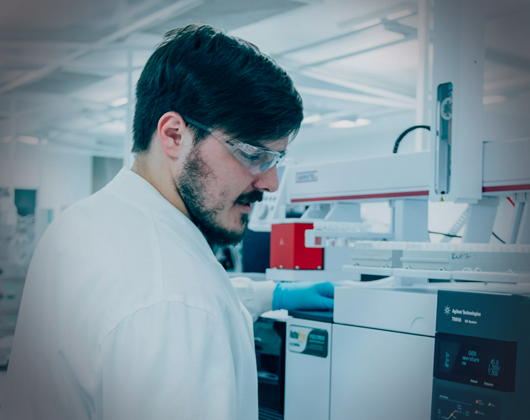The quantification of insulin analogues and other large peptides, such as glucagon-like peptide-1 (GLP-1) receptor agonists, plays an important part in improving the outcome of downstream formulation development and clinical trial activities. However, this growing class of biotherapeutics is known to present sensitivity challenges when trying to measure trace levels of these types of compounds, thus requiring advanced technologies such as 2D ultra-performance liquid chromatography-mass spectrometry (LC-MS).
At Quotient Sciences, we have developed and supported numerous insulin analogue, human insulin, and peptide/protein assays in the discovery, pre-clinical, and clinical stages of development. In this article, Michael Blackburn, Head of Bioanalytical Method Development and Labs at Quotient Sciences, describes the bioanalytical strategy that we employ to best support clinical studies for these types of compounds and how our physicochemical-based approach enables us to accelerate the development of bioanalytical assays for insulin analogues.
What are insulin analogues, and what challenges do they present to bioanalytical chemists?
Human insulin has a molecular weight of 5,808 Da and is made up of 51 amino acids in two chains joined together by disulfide bridges. Insulin analogues are versions of human insulin that have been modified slightly, by the addition or substitution of amino acids, or the addition of a side chain such as a fatty acid. This is done to modify the kinetics of the insulin in the body, making it either rapid-acting (prandial) or slow-acting (basal). Their action also depends on the formulation (injectable form) in which they are dosed. Enzyme-linked immunosorbent assay (ELISA)-based (ligand binding) assays cannot always distinguish between different insulin analogues or their metabolites. Mass spectrometry can offer a means of analyzing them simultaneously in a single assay.
How do you measure insulin analogues using mass spectrometry?
The typical mass spectrometers used in bioanalysis have an upper mass limit of 2,000–4,000 Da, but insulin analogues have masses of approximately 6,000 Da. We can measure them due to the phenomenon of multiple charging, which occurs in electrospray. This multiple-charging effect is incredibly useful because it produces clusters, which due to their charging fall into the mass-to-charge range of the mass spectrometer. For an insulin analogue or any large peptide, we can select one of these multiply charged clusters, usually the largest one, for fragmentation. Peptides and proteins fragment in predictable ways around the peptide amide bond, going in different directions to produce characteristic product ions, which help us to identify these insulin analogues.
What are hybrid assays?
Hybrid assays combine LC-MS with an immunoaffinity-based extraction technique – for example, using commercially available mass spectrometric immunoassay (MSIA) pipette tips or antibody-coated magnetic beads. Immunoaffinity extraction is very specific and provides a clean sample for mass spectrometry. Although our hybrid assay worked very well, it relied on a regular supply of specific antibodies and tips being available, and this was not always possible. This presented a need to change our analytical strategy to a more robust and reliable approach.
Why might you use a physicochemical approach?
Recent developments in solid-phase extraction technology and improvements in mass spectrometers have made a physicochemical approach a viable option. High-performance mass spectrometers, combined with specific product ions, can lead us to lower quantitation levels than were previously possible.
Immunoaffinity extraction can give you a very clean extract, as you are only pulling out the thing that will bind to your antibody. A physicochemical approach, such as solid-phase extraction, even if it is quite specifically tuned to your analyte, will pull out anything with the broad physicochemical interaction you are looking at, so you need a cleaner sample.
At Quotient Sciences, our strategy is based on three steps. Firstly, clean the sample and disrupt protein binding with a protein crash with acetonitrile and methanol, which removes the big albumins and the immunoglobulins. This is then followed by solid-phase extraction of the supernatant using either an HLB Prime or anion exchange column to clean the extract further. The sample is then injected. Our high-performance Waters Xevo TQ-XS Triple Quadrupole mass spectrometers follow a 2D approach, where the sample goes through a trapping column before it goes on to the analytical column. This enables us to load more of the sample to get better sensitivity and helps with robustness, as it provides an extra clean-up and switching step before you reach the analytical column. By combining this with modern column technology, we can get better peak shapes. Physicochemical assays may be more precise than hybrid assays, but they are slightly less sensitive, as the clean-up is less specific.
What are the particular challenges that you see with LC-MS bioanalysis of peptides?
The first challenge is non-specific binding with hydrophobic peptides, which can be prevented by using carrier proteins and low-bind surfaces. Secondly, passivation of the analytical system, particularly the UPLC column, is required to improve the peak shape. You also need to keep the background low, which can be achieved using solvent blank injections. A final issue is anti-drug antibody (ADA) effects, where the body sees the introduction of a foreign protein and develops antibodies against them, which can cause complications in analysis and produce anomalous results. Loss of internal standard is a giveaway sign, and it may occur with both hybrid and physicochemical approaches.
How do the results of LC-MS compare to ligand binding assays?
There is a general correlation between ligand binding assays and LC-MS, but do not expect an exact correlation. LC-MS measures concentration, whereas ligand binding assays measure activity. You need to consider what you want to measure – for example, total activity or specific concentration of the drug and metabolites. It may be faster to develop a mass spectrometry-based assay, as you do not need a specific antibody. However, if you do have a specific antibody, immunoassays may be more sensitive and may need a smaller sample volume. Pre-existing ADAs may interfere with both ligand binding assays and physicochemical assays, though to different degrees.
What key considerations should bioanalytical chemists be aware of for LC-MS of peptides?
LC-MS can give a fast and specific assay for large peptides and small proteins, particularly insulins, without the need for targeted antibodies. This makes it ideal for fast analysis in the discovery and pre-clinical phases of drug development. For the larger clinical phases, different considerations may apply – for example, sensitivity requirements or in-house facilities. You should also think about what you actually want to measure – for example, specific activity versus total activity. Generally, the two methods will give orthogonal and complementary data but are not exactly correlated, and you must bear in mind possible ADA effects. As a rule of thumb, most peptides or small proteins that are less than 10 kDa can now be readily quantified by LC-MS without the need for enzyme digestion or antibody-based clean-up. Larger proteins, such as monoclonal antibodies (mAb), usually require digestion before LC-MS analysis, which is a more complex workflow and can be less specific. There are new techniques, such as intact mass analysis using high-resolution mass spectrometry (HR-MS) or ion mobility, that may help to get around some of these issues of digestion.
To find out more about Quotient Sciences’ bioanalytical strategies for insulin analogues, and explore some recent case studies, watch Michael’s recent webinar entitled: "Bioanalytical Strategies for Insulin Analogues & Other Large Peptides Using LC-MS"
Learn more about how Quotient Sciences' bioanalytical services can support your drug development program by hitting the link below.

